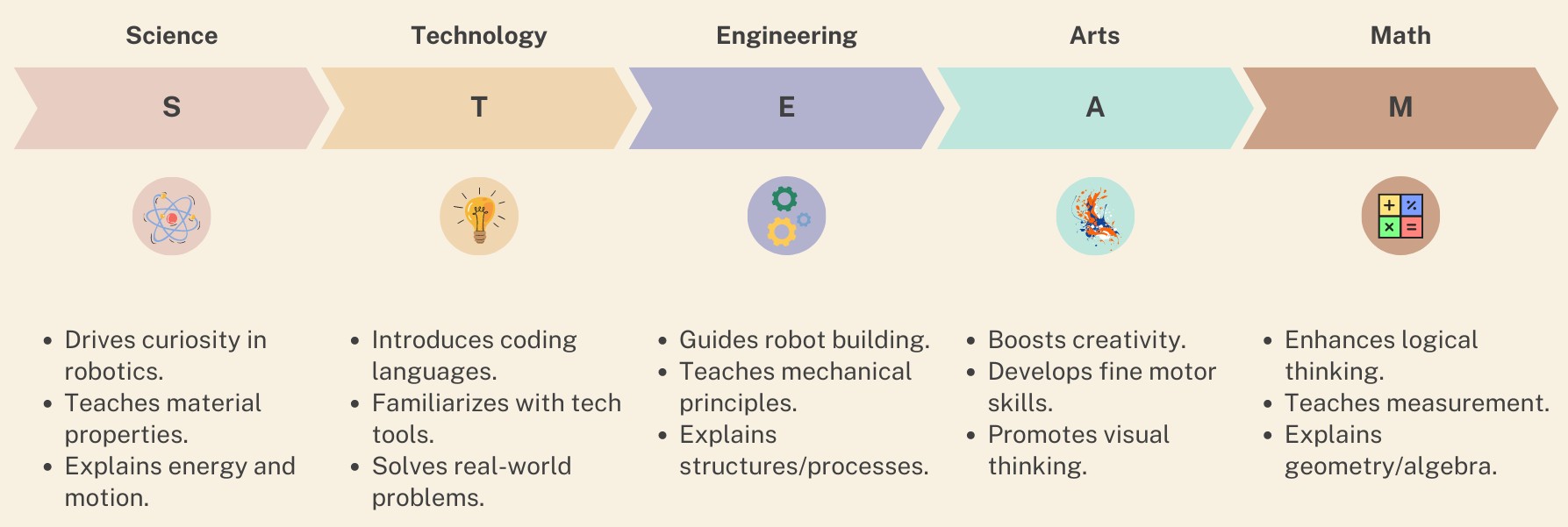Once, the idea of teaching robotics to my little Lincoln felt daunting – me, a non-coder, venturing into circuits and algorithms?
But surprise, it’s both doable and delightful! Robotics for kids can be simple and thrilling.
The real joy?
Witnessing Lincoln’s wonder as his creations stirred to life. This post is your non-techie guide to exploring robotics. Ready to embark on this captivating journey?
What Is Robotics For Kids?
Robotics is a distinct section within STEAM education that enhances the understanding and development of other STEAM areas like science, technology, engineering, arts, and math concepts.
Through its tools and methods, robotics individually and holistically nurtures all STEAM fields.
Kids get to design, build, and program robots, which is not just super fun, but also a great exercise in problem-solving and critical thinking.
Kids naturally develop a deeper understanding of coding and mechanical engineering principles by playing with robots and learning how to command them.
Robotics for kids is a delightful blend of play, learning, and preparing for a tech-oriented future!
Understanding the Basics of Robotics for Kids
It’s important for us parents to have a grasp of what robotics is and how to code, program, and build a robot with our little ones to ensure they get the most benefit out of the lesson. For preschoolers and kindergarteners starts with making the subject fun and approachable.
At a young age, you should help your child foster a sense of curiosity and enthusiasm about robotics and STEM/STEAM in general. However, it’s important to note that robotics can be difficult for some children because this area of focus incorporates many concepts from other areas of STEAM.
As your little ones learn robotics, it’s important for us parents to understand the basics that make it possible for kids to develop in the area of robotics:
- Fine Motor Skills (Art, Engineering): In robotics, children often need to assemble or manipulate small components. Developing fine motor skills through art projects like drawing, crafting, or through building blocks (engineering) will be beneficial when they start handling robotics parts. Check out some of my favorite STEAM building activities to help young learners build their fine motor skills.
- Basic Coding and Programming (Technology): Early introduction to coding can help kids understand how to give commands to a robot. STEM technology activities and platforms like Scratch Jr. help children learn about sequences, loops, and conditions in a fun and simple way, which are the foundations of the technology.
- Problem-Solving (Math, Science): Robotics involves solving different challenges requiring math and science skills. Many science STEAM activities require critical thinking and problem-solving can boost their ability to understand and fix issues when dealing with robotics.
- Spatial Awareness (Math, Engineering): Understanding concepts such as distance, space, and size is essential in robotics, linking closely to STEAM math and engineering. Activities that promote spatial awareness, like puzzles or building models, can benefit children exploring robotics.
- Creativity and Innovation (Art, Technology): Innovation is at the heart of STEAM and particularly important in robotics, where new solutions are always needed. Encouraging creativity through art can inspire children to think outside the box, enabling them to come up with unique solutions to the problems they may encounter in robotics. Be sure to check out some fun STEAM art projects to help your little ones develop creative and innovative thinking skills!

Encourage children to experiment and explore, helping them understand that it’s okay to make mistakes and learn from them. Remember, the goal isn’t to create mini roboticists but to stimulate interest, foster problem-solving skills, and show that learning about robotics can be exciting.
How To Overcome Common Obstacles When Learning Robotics For Kids
Learning about robotics, coding, and programming can be difficult for any child.
Because of this, it’s essential that you do robotics activities, games, and lessons with your little ones, especially as they are starting out. I want to share a few of the main obstacles you might experience and how to address each one to help your child stay engaged:
- Complexity: Use age-appropriate activities and games to teach the fundamentals, and break down concepts into simple, understandable parts and gradually increase complexity as your child’s understanding grows. It’s important to
- Frustration: Kids can get frustrated if the robot or code doesn’t do what they want. It’s important to work with your child to help them understand troubleshooting, problem-solving, and perseverance.
- Errors: Similar to the previous point, most children will have errors when they start programming, coding, and robotics. Be sure to teach your child about patience and help them understand the problem and how to find the solution.
- Lack Of Interest: Not all children immediately take to robotics, so you should read your child’s signals and react accordingly. You can make robotics more compelling by relating to their interests, like introducing them to a robot that creates art if they love coloring.
- Limited Time: Learning robotics can require a lot of time from you and your child. You can make the most of your involvement by making consistent, brief sessions instead of long sessions.
- High-Cost: There are no two ways around it because some coding robots for kids and other items can cost a lot of money on Amazon. But the good news is that there are many affordable and even free STEM technology activities, online resources, and apps to help teach the basic concepts of robotics, coding, and programming right at home.
- Impatience: Children may become impatient for several reasons, but many children get impatient if their robot does not work right away. You can use this as a learning experience to help your little ones learn about the value of trial and error. You should also celebrate small wins to keep them motivated and engaged.
Navigating the world of robotics doesn’t have to be an uphill battle for your child. By connecting to their interests, using age-appropriate tools, incorporating game elements, learning together, and celebrating progress, robotics can turn from a complex, intimidating subject into an exciting adventure.
Why Should Children Explore Robotics Early?
As a mom, I know how overwhelming the thought of introducing robotics to our kids can feel.
What initially felt like stepping into uncharted territory quickly turned into a fun and simple pastime that we both enjoyed. So, let’s chat about why our children should embark on this exciting robotics journey early on.
1. Makes Coding/Programming Fun
Imagine your little one creating a mini robot that dances or draws pictures. How cool is that? That’s the beauty of robotics – it brings coding to life, turning abstract concepts into something tangible and fun with coding activities or programming toys for kids!
Robotics for kids offers a hands-on approach that not only makes learning interactive but it also boosts your child’s understanding of cause and effect, which can support their overall growth and advancement.
2. Teaches Problem-Solving Skills
Robotics isn’t just techy fun. It’s a powerful way to teach problem-solving skills, a key component of early education, and essential in STEM learning.
These are the very same skills they’ll use in science to form hypotheses, math to work through complex problems, engineering to design structures, and technology to navigate new tools.
3. Encourages Creative Thinking
Delving into the world of robotics is like stepping into a big, beautiful canvas where your kiddo is the artist. They can build, code, and imagine their robots in countless ways, fueling that precious creative thinking.
Imagine your little one designing a robot to dance, programming their bot to navigate a homemade maze, or even inventing a robot helper for a pretend game. These playful scenarios promote inventive thinking, a skill they’ll use in future STEM ventures like designing experiments, inventing new technologies, or engineering structures.
4. Improves Engagement
Ever watched your little one completely absorbed, and lost in their world of play? That’s engagement. It’s key in early education, and let me tell you, robotics is a superstar at fostering it!
Robotics transforms abstract concepts into tangible, hands-on learning and makes learning stick.
5. Builds Computational Skills
When we talk about computational thinking in the world of kid-friendly robotics, we’re not just talking about math. We’re talking about a way of looking at problems that’s logical, sequenced, and super handy for our tech-filled world.
So, let’s get those robots moving and those brains buzzing, because computational thinking is a one-way ticket to future success in our digital world.
6. Improves Programming Skills & Thinking
Did you know that when your little genius is playing with their robotic toys, they’re not just having a blast, but they’re also learning to code? That’s right, robotics for kids is all about improving programming skills and enhancing computational thinking.
In the process of programming their robot to, let’s say, move in a square or follow a line, they’re getting hands-on with concepts like sequences, loops, and conditionals.
7. Introduces Teamwork
Kids robotics is the ticket to help kids develop life-long skills, but these lessons shouldn’t be learned alone. Building and programming robots often involve teamwork, an invaluable skill to pick up early in life and a key aspect of STEM education.
Teamwork in robotics mimics real-world STEM scenarios, where scientists, engineers, and tech experts often collaborate on projects. This collaboration can also extend beyond the build, like when kids participate in robotics competitions.
8. Helps Develop Fine Motor Skills
There are so many ways for your little ones to develop fine motor skills while learning, and robotics for kids is one such way! When your little one is piecing together a robot or pressing just the right spot on a tablet to program it, they’re giving their fine motor skills a serious workout.
These skills are oh-so-crucial for early education because they lay the groundwork for everyday activities like holding a pencil, tying shoes, or buttoning a shirt.
9. Fosters STEM/STEAM Learning
Similar to computer science as part of STEM, robotics is an area of learning that helps kids advance in their knowledge of STEM/STEAM education.
This holistic approach encourages well-rounded thinking and learning, making robotics a fantastic tool for early STEM/STEAM education. It’s not just fun and games – it’s setting the foundation for future academic and career success.
10. Prepares Kids For A Technological Future
In our fast-paced, tech-driven world, introducing robotics to kids early can give them a significant head start. It’s no longer just about knowing how to use technology; it’s about understanding how it works, how to manipulate it, and how to create with it.
Learning robotics exposes kids to coding and programming, key aspects of the ‘T’ and ‘E’ in STEM – Technology and Engineering. his early exposure to practical technology applications can spark an interest that propels them into related fields as they grow.
Fun DIY Robotics Projects for Kids
Diving into DIY robotics projects can be an exciting way for kids to learn while having fun. These hands-on activities transform abstract concepts into tangible learning experiences.
You can find many affordable projects, activities, and lessons in different STEM/STEAM disciplines to help your little ones learn robotics without breaking the bank
You’ll be surprised how everyday items around the house can be used to create simple ‘robots’. From crafting a doodling robot out of a toothbrush and a tiny motor, to constructing an arm-waving ‘bot from cardboard, here are some great low-cost DIY projects:
- Bristlebot: This is a tiny robot that uses a toothbrush head and a small motor to move in funny ways. It’s a great project for learning basic concepts about motors and movement. More information.
- Art Bot: An art bot is a fun project that combines creativity with science. Children can create a robot that can draw patterns while introducing them to circuits. More information.
- LED Throwies: This project teaches kids about electricity and circuits. It’s about creating a little LED magnet that they can stick to anything metallic. More information.
- Cardboard Robotic Hand: A fantastic DIY project for understanding the basic principles of robotic design and biomechanics using simple materials like cardboard and string. More information.
- Scribble Machines: These are fun DIY robots that create art by moving in unusual ways and leaving a trail of markings. They’re a great way to explore the relationship between science, technology, engineering, and art. More information.
The magic lies in the process: imagining, creating, troubleshooting, and reveling in the joy of seeing their very own robot come to life!
The Best Robotics Kits For Kids
As we discussed in the previous section, there are lots of great affordable (and free) projects around robotics for kids. I also found several engaging toys for kids that make learning robotics fun and rewarding.
While these toys cost money, they are a great gift because they’re interactive tools that help kids develop valuable skills. As your little ones command their robot friends to move, light up or make sounds, they’re being introduced to basic coding concepts.
Here are some of my favorite robotics toys for a preschooler and kindergartener:
- Learning Resources Code & GO Robot Mouse: This robotics toy is perfect for preschoolers (4+ years old) taking their first steps in robotics. This interactive toy makes learning coding concepts fun and easy, engagingly stimulating problem-solving skills. Learn more here.
- Kids First Coding & Robotics: My son (and I) fell in love with this toy because it is the perfect for budding young coders aged 4-8. With no screens or electronics, it uniquely teaches coding and robotics through hands-on play, promoting logical thinking and creativity. Learn more here.
- Lucky Doug 12-in-1 STEM Solar Robot Kit: This affordable robotics toy is perfect for young learners exploring robotics. Its solar power feature and multiple build options brilliantly blends fun with foundational STEM concepts, sparking creativity and curiosity. Learn more here.
- Learning Resources Botley The Coding Robot 2.0 Activity Set: This is an ideal starter kit for kids aged 5 and up to explore coding and robotics. Screen-free coding and fun challenges foster creativity, logic, and problem-solving in an interactive, kid-friendly way. Learn more here.
These hands-on experiences also give them a head start in math and logical thinking. Plus, robotic toys can boost problem-solving skills as kids work out what commands to give to achieve desired results. So, when it’s time to pick a toy, remember—robotics toys are both engaging and educational, making them a fantastic choice!
Support Your Kids As They Learn Robotics And STEM!
As we wrap up this robotics adventure, remember every moment spent exploring, experimenting, and even getting things ‘wrong’ is a step towards learning and growth.
Your support and encouragement will fuel your little one’s curiosity and confidence in the world of robotics. Yes, it might seem like a futuristic field, but with these tips, resources, and a dash of patience, you’ve got this, and so do your kids!
So, let’s embrace this wonderful journey of discovery, nurture these budding roboticists, and who knows, we might just be raising the inventors of tomorrow’s most amazing robots!







0 Comments